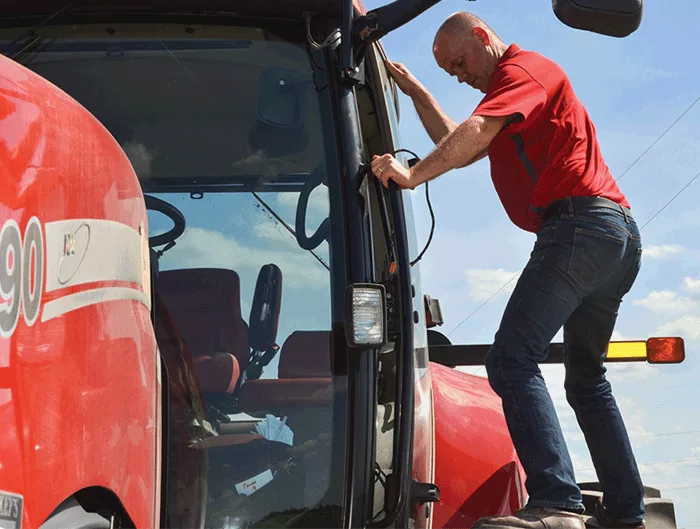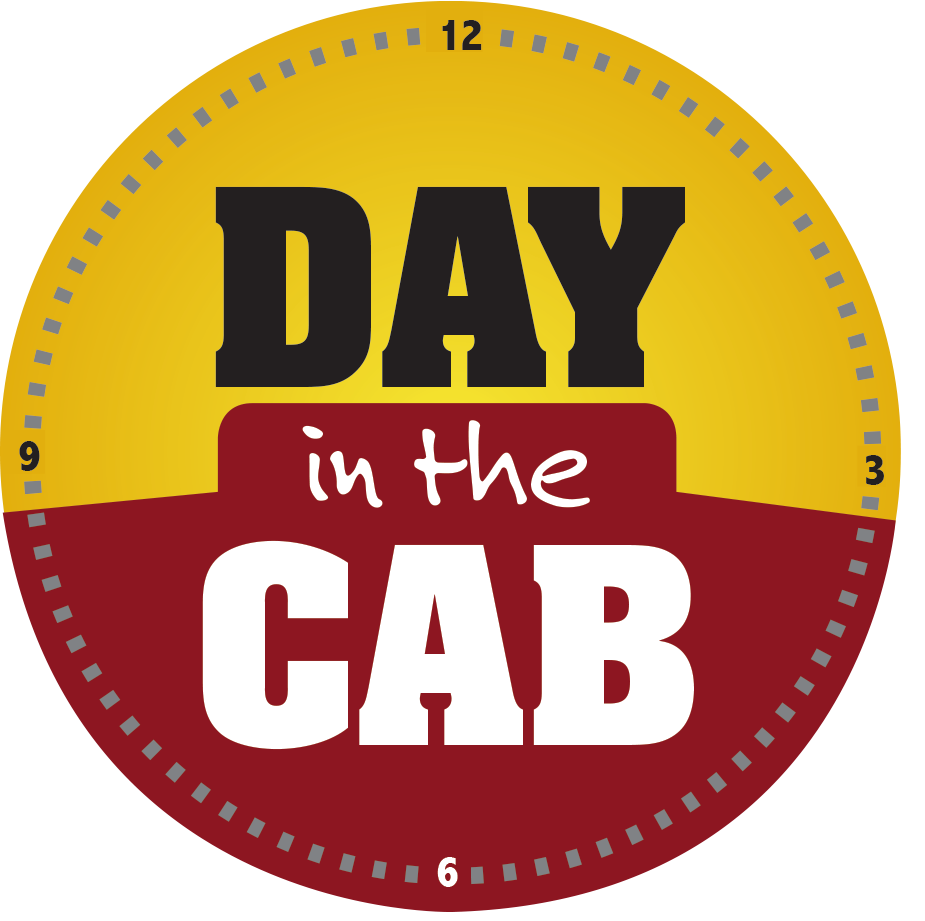
Soon after becoming technology editor for Precision Farming Dealer, one of the first precision specialists I had the chance to meet was Darin Kennelly with Birkey’s Farm Stores, a Case IH dealership group in Illinois.
One of the lasting impressions I took from our conversation was then that even after nearly a decade on the job, no 2 days were ever the same for Darin. We’ve worked together on several occasions since that initial meeting, and I was thrilled to be able to spend an entire workday with him for this piece.
As was my objective with our first Day in the Cab last spring, I wanted to live and breath the minutia of Darin’s day — from the early morning customer callbacks and tentative day planning, to providing puzzle-piece solutions during sometimes patience-testing service calls.
During my day with Darin Kennelly, I shot videos of my experiences along the way. Check them out here >>
Darin joined Birkey’s in 2005 as the dealership’s sole precision farming specialist. Today, the dealership group has precision specialists at each of its 12 locations in Illinois, and Darin thrives on somewhat of a nomadic existence, dividing his time between Birkey’s locations in Annawan, Galesburg, Henry, Macomb, Polo and Prophetstown.
But Darin prides himself on being available and accessible to customers whether he’s on the road or in the office. I witnessed this first-hand after spending more than 9 hours with Darin, in the office and on a pair of challenging, yet successful customer visits on the heels of a hectic planting season.
I headed home with a more intimate understanding of how seemingly routine software upgrades can turn into tedious, time-consuming jobs, why lunch is often a luxury and with some unusual advice on how to repel a relentless swarm of gnats.
4:45 a.m. Morning comes early and I revel in the tranquility for a moment before the silence is broken by our cat scampering down the stairs, disturbing our dog. Thankfully, the ruckus doesn’t wake anyone else and I silently slip out.
5:47 a.m. With a cup of coffee already consumed and the sun starting to shine, I hit the road. It’s an easy 140-mile ride across the Illinois border to the Birkey’s Farm Store dealership in Polo, where I’ve arranged to start the day with Darin.
It’s been a rather wet week in the area, and the only activity in fields I pass along the way is a couple of sprayers making post-planting applications.
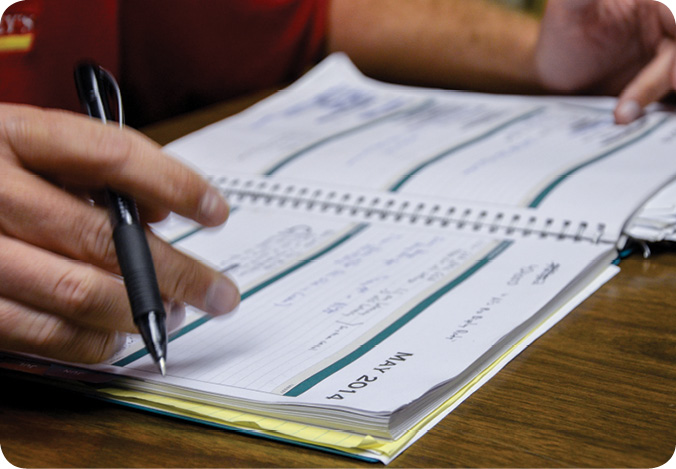
Darin relies on a paper calendar for lists and daily reminders. “I’m ancient, but this works for me,” he says. “I’m on the phone and on the road most of the time, so this is something I can easily reference for a parts number or customer phone number.”
8:05 a.m. I arrive at the dealership, which is pretty quiet on this Friday morning. I find Darin in the conference room. It was about a 2-hour commute from his home near Galesburg in western Illinois, but Darin says he often spends time working out of different locations. During peak seasons, Darin may bounce between several store locations in one day, depending on the volume of service calls and where he’s needed most.
“My service van is basically my home store,” he says. “I don’t have an office, per se, at a dealership, but can always find space if I need it.”
Having survived another hectic planting season — which is all about “survival” — Darin tries to shift focus to precision sales, but also helps other specialists with lingering support calls.
8:24 a.m. Our morning starts with a call to Mike Robling, Birkey’s parts asset manager. I notice that Darin uses a headset synched to his cell phone for the call and he says he prefers the hands-free approach, so he can take notes or work on equipment if he’s in the field.
The call with Mike is to get Darin’s input on whether or not the dealership wants to expand its inventory of Truesight combine row guidance systems manufactured by Headsight Inc. Birkey’s has had success selling the technology in the past and some locations see an increased opportunity to market and sell the corn header guidance kits during the summer months.
“We’ve got a lot of guys running guidance for soybeans, but not for corn,” Darin says. “We want to evaluate our inventory and consider how many of these systems we want to order in preparation for the fall.”
The consensus is to further research the sales potential and purchase cost, before making a decision. Darin says one of his roles is often to communicate with each store’s precision specialist and relay the sales needs of each location to management.
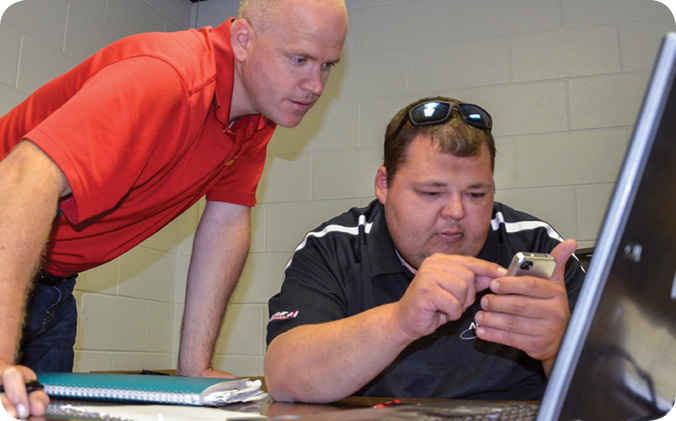
Darin collaborates with fellow precision specialist Steve Ackeberg on the day’s agenda. “I like guys who keep to-do lists, even if it’s just what they hope to get done, because it keeps people on target,” Darin says.
“If it comes down to writing a big check, it’s not my decision,” he says. “I’ll compile the pros and cons and look at cost, then fire a report off to management who makes the call.”
9:01 a.m. Darin returns a call from earlier and leaves a message for a customer who is having trouble getting the section control on his sprayer to work. Knowing the customer well, Darin isn’t sure if he’ll hear back from him.
“It’s one of those things where he may never call back, or if I call back later he’ll have solved the problem,” he says.
Without a true office, Darin relies on his cell phone to keep in touch with customers throughout the day. He says more customers have begun texting him, especially if they have quick questions that only need short replies. Depending on his schedule, Darin will try to use the early morning to catch up on emails, but he’s had little time so far today.
9:10 a.m. Life interrupts the morning with a call from Darin’s wife letting him know they have a sick child at home. He says he’ll try to hurry home after work. With 6 children, Darin jokes, that “the odds of not having someone sick are pretty small.”
9:21 a.m. We’re joined by Steve Ackeberg, precision farming specialist with the Polo store. He’s been with Birkey’s for 16 years, starting in the parts department.
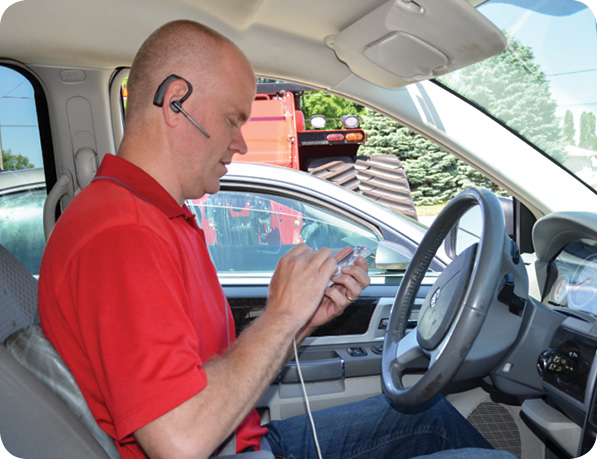
Darin admits he isn’t shy about getting on the phone with other specialists throughout the day, rather than assume a customer has kept current on their precision upgrades.
He and Darin discuss a couple of customer visits that we’ll be making this afternoon. Steve gives us some background on the problems the customers are having and directions to the farms. Darin opens his calendar book, which has dog-eared corners and papers protruding. He flips through a few pages and makes some additional notations. While Darin logs appointments on his smart phone, he relies on the paper calendar for “to-do” lists and daily reminders.
“I’m ancient, but this works for me,” he says. “I’m on the phone and on the road most of the time, so this is something I can easily reference for a parts number or customer phone number.”
Darin prides himself on daily organization and personally sets a high performance standard each day. “I like guys who keep to-do lists, even if it’s just what they hope to get done, because it keeps people on target,” he says. “I always like asking potential hires how they keep organized.”
9:44 a.m. Darin ends up getting a call back from the customer who is having trouble with his sprayer. It ends up being and issue with the automatic shutoffs, not the section control.
Darin pulls up a simulation of Case IH’s Pro 700 display on his computer to investigate the cause and talks the customer through the solution, which is a simple setup issue for the sprayer’s connection to the display. Being able to refer to the simulation saves a trip to the field, but Darin is looking forward to the day when he can remotely log into a customer’s monitor with telematic service.
9:55 a.m. Darin gets a text from a former precision specialist with the dealership wishing Darin a Happy National Donut Day. Sadly, none of us remembered, and the dealership is devoid of donuts, so we forego the celebration.
10:00 a.m. Darin and Steve log into a dealer conference call with Ag Leader to learn more about the precision manufacturer’s upcoming product field days in Illinois. Though not mandatory to attend, Darin says the field days can offer an opportunity for the dealership’s precision staff to network and interact with potential customers. But at the same time, Darin says there can also be a lot of competition to contend with, depending on how many other precision specialists from local dealerships attend.
10:28 a.m. As the Ag Leader call winds down, Darin’s smart phone buzzes to let him know his battery is low. It’s not unusual for Darin to have to charge his phone several times throughout the day.
“It was fully charged when I got to the dealership this morning and it’s already drained,” he says. “We can charge it in the van.”
We double check directions to the service visits we’ll be making and Steve draws us a map on a piece of scrap paper. Ironically, Darin doesn’t typically utilize GPS when making customer calls, because he knows his service area extremely well.
10:47 a.m. We jump in Darin’s service van en route to Freeport, which is about 30 minutes north of Polo to visit Keith Hinrichs, who is having trouble getting his auto-pilot system to engage on his Case IH MX 285 tractor. Darin is unsure of how long a job like this could take, given that he isn’t quite sure what the problem is.
“These are the jobs I always worry about because I am walking in without knowing what the problem is,” he says.
I notice that the odometer in the van reads 167,646 miles, the bulk of which Darin put on since he go the van in 2010. Darin notes that for a job like this, remote service would be especially useful because he could ideally diagnose the fault messages from the office, rather than have to make the trip to the field.
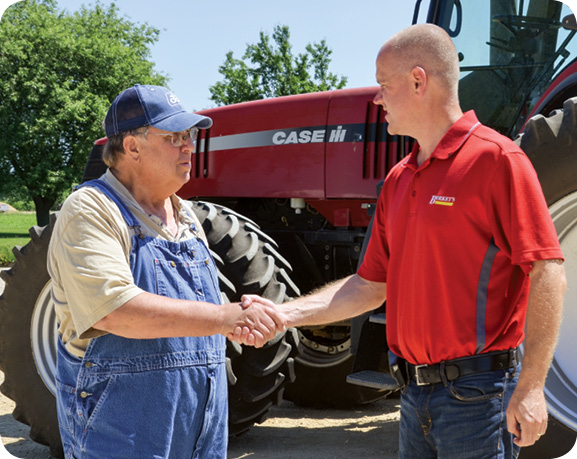
Meeting with farm customer Keith Hinrichs, Darin says, it’s worth taking the extra time while on-site to make sure he’s up and running, rather than have to make another trip out.
11:01 a.m. Darin gets a call from his Case IH sprayer rep looking for assistance on how to load a prescription onto a sprayer. Brief calls with questions about setups or logins are relatively common and Darin recently began filming YouTube customer tutorial videos to help.
11:26 a.m. The sun is shining — a rarity so far this spring — and it’s starting to warm up as we arrive at the farm and meet Keith and his operator, Al Bawinkel. They explain to Darin the “fault” messages they’ve been receiving on their Pro 700 display when trying to get the auto-steer system to engage with their Case IH planter.
12:10 p.m. Darin and I hop in the tractor cab and he logs into the system with his laptop to try and diagnose the problem with the auto-steer connection. His first inclination is that there could be a problem with the navigation controller, as the customer has sent the system in for maintenance in the past. But a check of the system shows that the orientation and pitch are working fine, and Darin says we may be in for a long afternoon.
“Very rarely do I come out on a service call like this where I’m not here at least an hour or two, trying to figure what the problem is and what caused it,” he says. “But sometimes events like this can take multiple days if it’s a component or a wiring issue.”
12:23 p.m. Darin checks in with Steve to get some more information on the customer and any recent updates he’s made to the system. Darin admits he isn’t shy about getting on the phone with other specialists throughout the day, rather than assume a customer has kept current on their precision upgrades.
“I always keep in contact especially on a job like this because I don’t want to make a radical update that could negatively impact other equipment they may be using the same system on.”
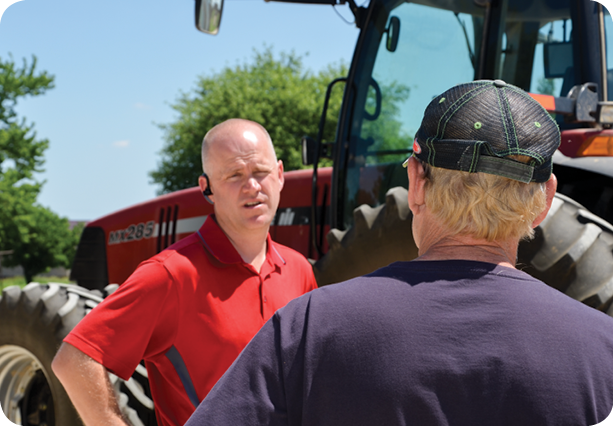
Keeping an ongoing conversation with customers is critical to efficient service. “There’s nothing more frustrating than finding out after the season the customer was having a problem and he never called and told us,” Darin says.
12:40 p.m. Updating an older version of communication software between the navigation controller and auto-steer unit does the trick and the system engages, but Darin wants to have Al test drive the tractor in the field to make sure he’s satisfied. Leaving a job without knowing if a problem is fixed is something Darin says he always tries to avoid.
“It’s worth taking the extra time while I’m on-site to make sure the customer is up and running, rather than have to make another trip out,” he says. “There’s nothing more frustrating than finding out after the season the customer was having a problem and he never called and told us, which is why I want to keep that line of communication open so we can get it fixed.”
Al takes the wheel with Darin in the passenger seat and I wedge myself into the padded area behind the driver’s seat. We drive to an adjacent soybean field where Darin helps Al set the header and they engage the auto-guidance system with the planter.
The soybeans have just begun to emerge and Al cringes as we temporarily run down a row of plants. “They are pretty resilient, so we’ll be OK,” he says, quietly.
After about 10 minutes testing the system, everyone is satisfied and we head back to the farm.
12:55 p.m. Darin finishes up by double-checking to make sure the GPS system is synched with the planter. Before we leave, Darin is very conscious to ask Al if he has any additional questions or concerns. The only one that comes to mind is figuring out a repellent for the relentless swarm of gnats that have pestered us most of the morning. Darin says they have been a nuisance all spring in northern Illinois, but they are particularly aggressive today.
Al’s “theoretical” prescription is either dabbing a little Absorbine Jr., behind the ear, or hanging a cherry vanilla air freshener in the tractor cab. We joke that we may end up putting the remedies to the test if we can’t shake the pests throughout the afternoon.
1:17 p.m. Darin and I hop into his van and are en route to Harmon, Ill., and Kirt Swanson’s farm to upgrade his GPS from a Wide Area Augmentation System (WAAS) signal to Trimble’s RangePoint RTX. Kirt is running a Case IH Pro 700 monitor and a 372 Global Navigation Satellite System (GNSS) receiver and wants to take the next step up the accuracy ladder with his guidance system.
Darin doesn’t recommend that customers use WAAS for planting because a higher level of accuracy is better suited for the field operation. But in this case, the customer wanted to start slow and gradually upgrade systems.
“These tend to be good sales opportunities because accuracy is very addictive,” Darin says. “When a customer starts with a basic system, we want them to upgrade once they get familiar with it.”
1:20 p.m. It’s about a 45 minute drive, so Darin offers to stop for a bite on the way. I feel fortunate, because Darin says lunch is often a luxury for him. He typically works through the day, rarely taking time to eat a traditional meal. This is especially true during the peak planting and harvest seasons.
“I’m not going to enjoy my meal if I did stop and eat because I’d just be thinking about where I should be,” he says. “I know some guys will stop and take a 15 minute break even if they are really busy, but that’s not me.”
Darin says his phone has been unusually quiet today and during the off-season, he may bring a sandwich or snack, but is more prone to eat when it’s most convenient, not necessarily when he’s hungry. “I know some of the guys will joke and say, ‘Don’t work with Darin, you won’t get to eat lunch,’” he says.
1:46 p.m. We pull into Subway and I grab a 6-inch ham and cheese sub with an iced tea. Darin orders a 6-inch spicy Italian (his “go-to” sub) and a Dr. Pepper. On our way out we see a Hagie sprayer pull into the parking lot and we wonder if the operator is going to try to use the drive through.
2:16 p.m. We arrive at Kirt’s farm, but he isn’t there. Unable to enter the equipment shed, Darin calls Steve who has a key code to open the door to the shed. Darin hops into the cab of the Case IH 290 Magnum and backs it out to the yard and plugs into the GPS system with his laptop.
This is a fairly routine upgrade and Darin expects the job to be a relatively quick fix — estimating a half-hour or so — to install a $250 upgrade to the RangePoint RTX correction subscription.
2:32 p.m. Darin calls the OmniStar support line to get the activation code for the RangePoint subscription, but ends up having to re-key the code a few times after receiving several “fail” messages.
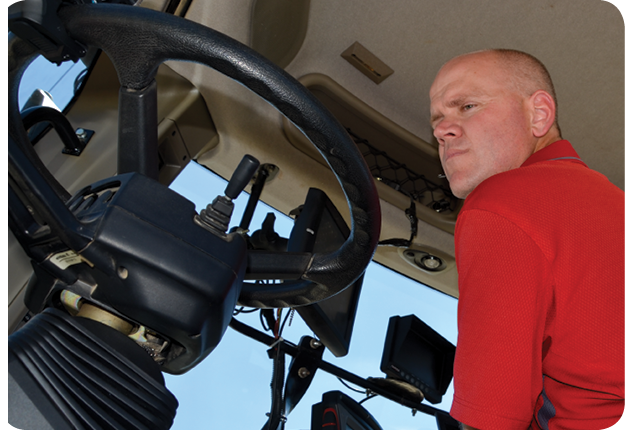
It’s not always easy to diagnose precision problems until getting on the farm, Darin says. For those “unknown” issues, he tries to carve out at least an hour or two, trying to figure out what the problem is, and what caused it.
The problem ends up being an omitted dash that the support person forgot to include when relaying the code. When dealing with long series of numbers in activation or “unlock” codes, Darin says on occasion a number or symbol gets missed.
“I’ll always read back the code once I get it to make sure I heard it correctly,” he says. “Sometimes, it takes a few tries, but I’m always relieved when it’s a simple issue like that.”
2:55 p.m. A neighbor rolls up in a John Deere Gator RTV looking for Kirt. We introduce ourselves and Darin explains the GPS upgrade he’s installing. During the course of conversation, the neighbor casually mentions that he’s having trouble with his RTK signal and asks about the compatibility of “red technology with green equipment.” Darin hands him a business card and says to give him a call sometime to talk.
“You never know,” Darin says with regards to potentially landing a new customer.
3:21 p.m. The upgrade isn’t going nearly as smooth as Darin anticipated. Although the RangePoint system is activated, we are waiting to acquire a satellite signal to test it. Typically, it takes about 10 minutes to pick up a signal, Darin says. There is little that can be done other than to wait, and Darin admits that this can be one of the more frustrating parts of the job.
“Luckily, this customer doesn’t need to be in the field today, so it’s not extremely urgent,” Darin says. “But this job requires a lot of patience and I can spend quite a bit of time waiting for something to lock on or converge, and even once it does, I’ll take extra time to make sure it works.”
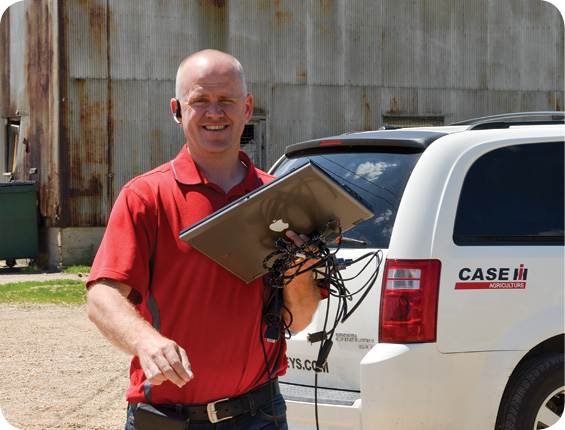
Lunch is often a luxury for Darin. He typically works through the day, rarely taking time to eat a traditional meal. “I’m not going to enjoy myself if I did stop and eat because I’d just be thinking about where I should be next.”
4:03 p.m. Darin leaves a message for Kirt to see if he owns the field across the street from his farm so we can test the strength of the signal once it converges. In the meantime, we continue to wait and Darin tries switching from the central satellite beam to the eastern one to see if he can draw a stronger GPS signal, to no avail. He had considered making one more customer visit this afternoon, but that is unlikely at this point.
4:20 p.m. Kirt calls back and during the conversation, the GPS signal finally locks on. Darin is clearly relieved and lets Kirt know that we’re going to wait to make sure it stays connected and calibrate the system.
4:34 p.m. We wait about 15 minutes to make sure the acquisition took and Darin asks me to help him do a roll calibration of the new signal. This will ensure that the system tracks on the same coordinates when the operator turns or changes direction in the field.
Kirt’s driveway is suitable for the test and Darin places two screwdrivers in the shape of a ‘T’ directly below the center of the tractor hitch. He’ll make at least five passes with the RangePoint system engaged and log the distance in inches between the center of the hitch and vertically placed screwdriver.
My job is to signal Darin from outside the tractor when the center of the tractor hitch passes the screwdrivers. Once he has an accuracy average he’s satisfied with, he inputs the numbers into the system.
“I’m pretty picky about it, especially if I’m doing this check for RTK, I want it to be perfect,” Darin says. “In this case, I still want it to be as accurate as it can be so the customer is satisfied. Once I know how far I’m off, I can upload the numbers into the computer and change the roll angle in the tractor.”
4:48 p.m. We finish the tests, pack up and head back to the dealership. Darin admits that he could have probably come back another day to try and acquire the RangePoint signal, but he doesn’t like to leave unfinished business for another day if he doesn’t have to.
“I’m not the kind of guy who will try to cram as many visits in a day as I can and tell customers I have to rush off to the next appointment before solving their problem,’ he says. “I’d much rather make half as many visits and not have to come back because the job didn’t get done.”
5:17 p.m. We arrive at the dealership and notice that pretty much everyone has called it a day. The store is closed and Darin and I shake hands and part ways. We both have a couple hours of windshield time ahead of us heading home, but we agree that it’s been a productive Day in the Cab for both of us. 

